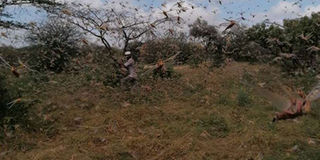Challenges and object lessons in reporting the invasion of locusts

Desert locusts invade Taiboto, Isiolo County, in January 2020. The media, including NMG, play a vital role in informing the public accurately about the invasions. PHOTO | FILE | NATION MEDIA GROUP
What you need to know:
- Moses Mugendi, a physical/urban planner and small-scale farmer in Mbeere, Embu County, says he has keenly followed the coverage as the invasion affects him directly.
- The media, including NMG, play a vital role in informing the public accurately about the invasions. And NMG has played a commendable role in that aspect.
In the book of Exodus 10:12-19, it is reported that the Lord told Moses to stretch out his hand over Egypt so that locusts swarm over the land and devour everything growing in the fields.
“So Moses stretched out his staff over Egypt, and the Lord made an east wind blow across the land all that day and all that night. By morning the wind had brought the locusts; they invaded all Egypt and settled down in every area of the country in great numbers.”
The Holy Bible says the locusts covered all the ground until it was black and devoured everything growing in the fields and the fruit on the trees.
Later, the Lord decided to take away the plague. “And the Lord changed the wind to a very strong west wind, which caught up the locusts and carried them into the Red Sea. Not a locust was left anywhere in Egypt.”
Of all locust invasions, this is the easiest to report and explain. It is attributed to a divine agency.
It does not follow the usual laws of nature and scientific explanation. No hard questions are asked.
EXTENSIVE COVERAGE
The same cannot be said of the reporting of the invasion of desert locusts and outbreaks of grasshoppers in northeastern Kenya, however.
The desert locusts are said to have originated from Ethiopia and Somalia. Reporting and explaining the invasion is challenging and daunting and a real test of knowledge and journalistic skills.
There is no simple and divine explanation of such swarms of locusts.
The media, including NMG, play a vital role in informing the public accurately about the invasions. And NMG has played a commendable role in that aspect.
It has so far published more than 20 stories, running into more than 12,000 published words and dozens of pictures.
A team of 21 reporters and writers have been deployed. In their coverage, they have talked to farmers, officials, politicians and entomologists and consulted the Food and Agriculture Organisation (FAO) of the United Nations.
The extensive coverage has been commended by readers.
HOLDING STATE TO ACCOUNT
Moses Mugendi, a physical/urban planner and small-scale farmer in Mbeere, Embu County, says he has keenly followed the coverage as the invasion affects him directly.
“I am an ardent follower of NTV and reader of the Daily Nation and I like the quality of the investigative and topical features — including exposés, which are usually done with a high level of professionalism.
I also love the way NMG builds pressure on the government on issues that affect the citizenry by consistently airing them until intervention is made.”
But he says although the coverage has been consistent, reporters have not accurately identified some of the insects.
“I have noted erroneous reporting as desert locusts of the swarms of Horse Lubber grasshopper species (Taeniopoda eques) spotted in Kirinyaga and parts of Isiolo. Kindly note that the image used in the article (on Kirinyaga) is that of the Lubbers.” The article, “Locusts spotted in Kirinyaga village,” (Daily Nation, January 13) talked of “desert locusts”.
QUALITY REPORTING
Mr Mugendi says in Mbeere, where the Horse Lubber grasshoppers swarm after heavy rains, those locusts are locally known as mburi murengi (as they swarm and feed like goats).
“They are heavy feeders and capitalise on euphoria (kariaria) and other tree species with milky sap or fleshy leaves.”
The NMG coverage is instructive. Its object lessons, so far, are summed up in the front-page story, “Kenya pays dearly for failure to act on locust warning”, by Isaiah Esipisu, published in the Daily Nation of Wednesday.
It quotes Dr Eston Mutitu, an entomologist, saying that the Ministry of Agriculture failed to act on the early warning of a possible locust invasion given by the FAO.
In the same issue, an article titled “Poor, slow response to invasion worrying” by Aggrey Omboki criticises the Kenyan leadership for the casual away in which it had reacted to the invasion.
Thanks to the Nation Team. Without the saturation coverage by NMG the object lessons might well have been lost.
Send your complaints to [email protected]. Call or text 0721 989 264





